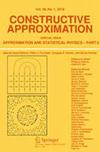非多项式 q-Askey 方案:积分表示、特征函数特性和多项式极限
IF 1.2
2区 数学
Q1 MATHEMATICS
引用次数: 0
摘要
摘要 我们构建了 q-Askey 方案的非多项式广义。q-Askey方案的元素是由q-超几何级数给出的,而非多项式方案的元素是由等值线积分给出的,其积分是由Ruijsenaars的双曲伽马函数建立的。另外,积分也可以用 Faddeev 的量子稀对数、Woronowicz 的量子指数或 Kurokawa 的双正弦函数来表示。我们介绍了该方案所有元素的基本特性,包括它们的积分表示、联合特征函数特性和多项式极限。本文章由计算机程序翻译,如有差异,请以英文原文为准。
Non-polynomial q-Askey Scheme: Integral Representations, Eigenfunction Properties, and Polynomial Limits
Abstract
We construct a non-polynomial generalization of the q-Askey scheme. Whereas the elements of the q-Askey scheme are given by q-hypergeometric series, the elements of the non-polynomial scheme are given by contour integrals, whose integrands are built from Ruijsenaars’ hyperbolic gamma function. Alternatively, the integrands can be expressed in terms of Faddeev’s quantum dilogarithm, Woronowicz’s quantum exponential, or Kurokawa’s double sine function. We present the basic properties of all the elements of the scheme, including their integral representations, joint eigenfunction properties, and polynomial limits.
求助全文
通过发布文献求助,成功后即可免费获取论文全文。
去求助
来源期刊
CiteScore
3.50
自引率
3.70%
发文量
35
审稿时长
1 months
期刊介绍:
Constructive Approximation is an international mathematics journal dedicated to Approximations and Expansions and related research in computation, function theory, functional analysis, interpolation spaces and interpolation of operators, numerical analysis, space of functions, special functions, and applications.

 求助内容:
求助内容: 应助结果提醒方式:
应助结果提醒方式:


